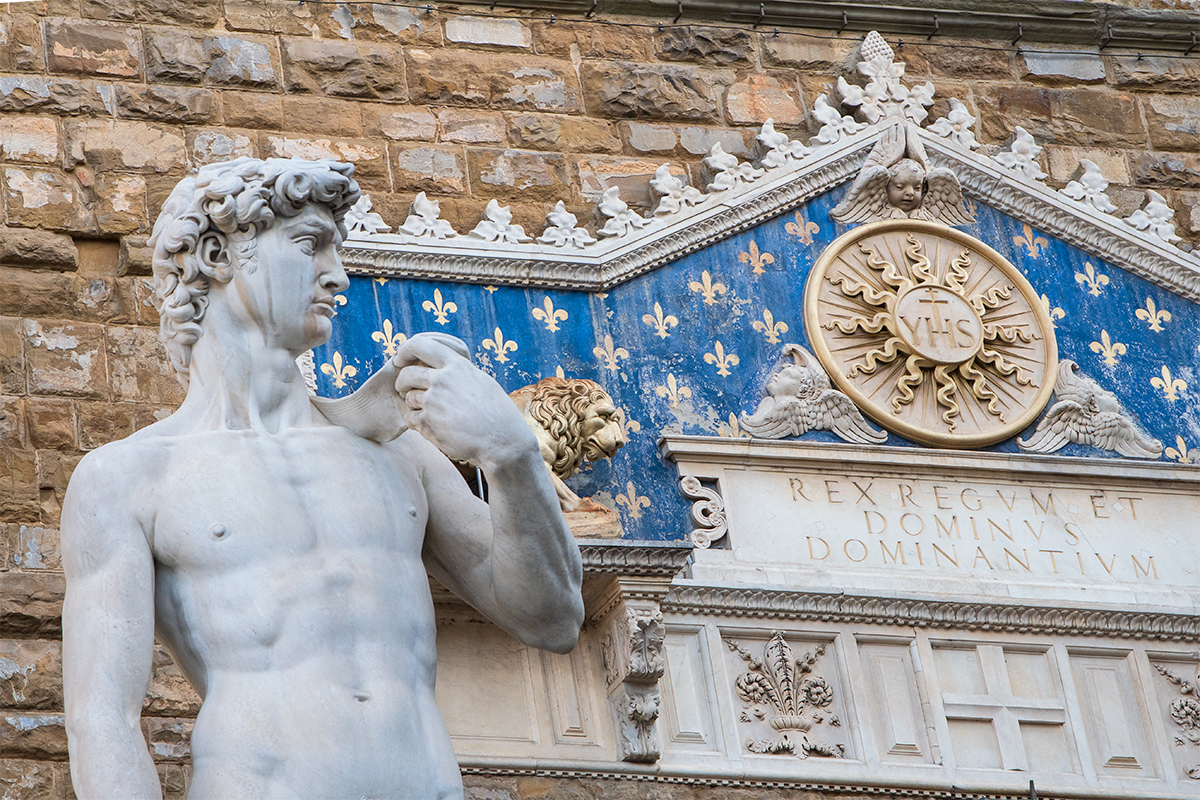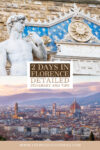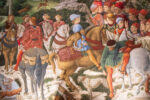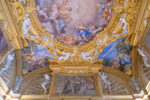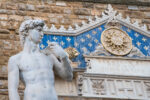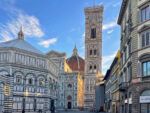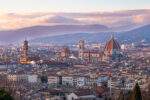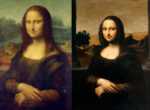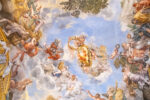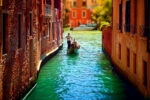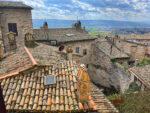As a 2,000-year-old city and the cradle of the Renaissance, Florence is a captivating city to explore. There are enough things to do in Florence to keep you busy for weeks. But even if you only have 2 days in Florence, the city will sweep you off your feet.
If you are in the early stages of planning your itinerary, 3 days in Florence will give you a more enjoyable experience, especially if you are an art buff. You can spend an entire day just visiting all of Michelangelo’s works, for example.
But if time is tight, perhaps you are planning a weekend break in Florence, this 2 days in Florence itinerary gives you enough flexibility to set your own pace while ensuring you don’t miss any of the essential sites in the city.
The most important thing you can do to maximize your time in Florence is to buy all tickets in advance. Yes, it takes careful planning since many attractions have timed entry, but this will save you literally hours of standing in queues. And depending on whether you visit Florence in winter or summer, some attractions can be sold out closer to your dates.
If you do find yourself in Florence needing a last-minute ticket to a sold-out museum or a palace, you can try your luck with third-party providers like GetYourGuide or Viator.
Where to Stay in Florence
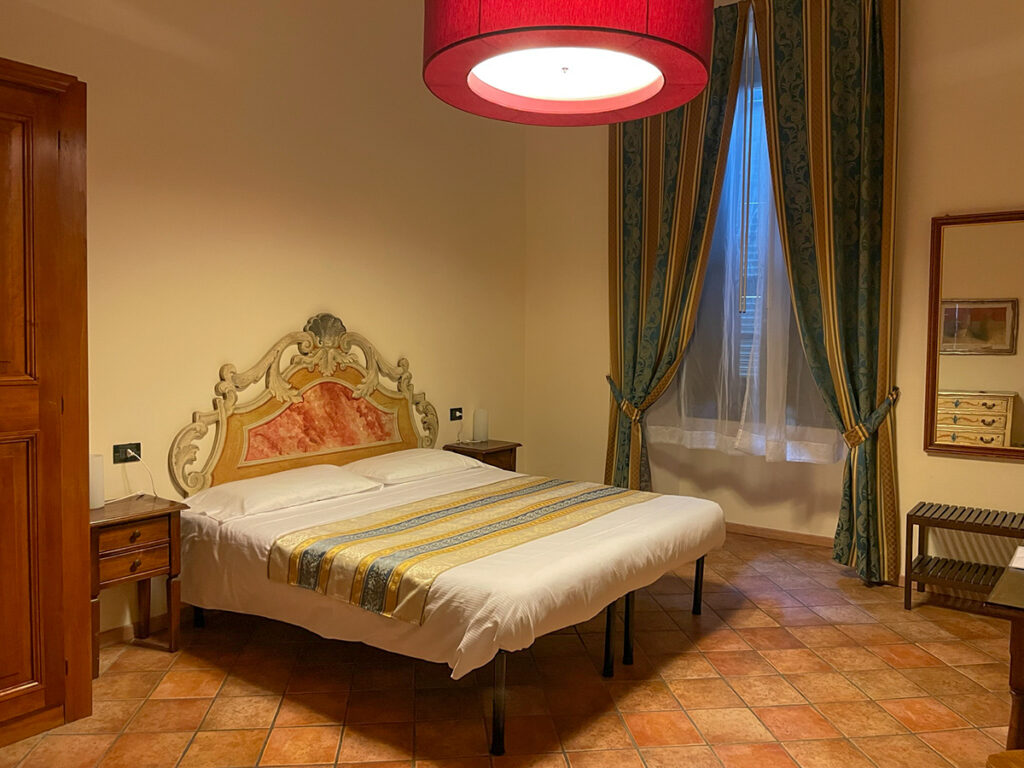
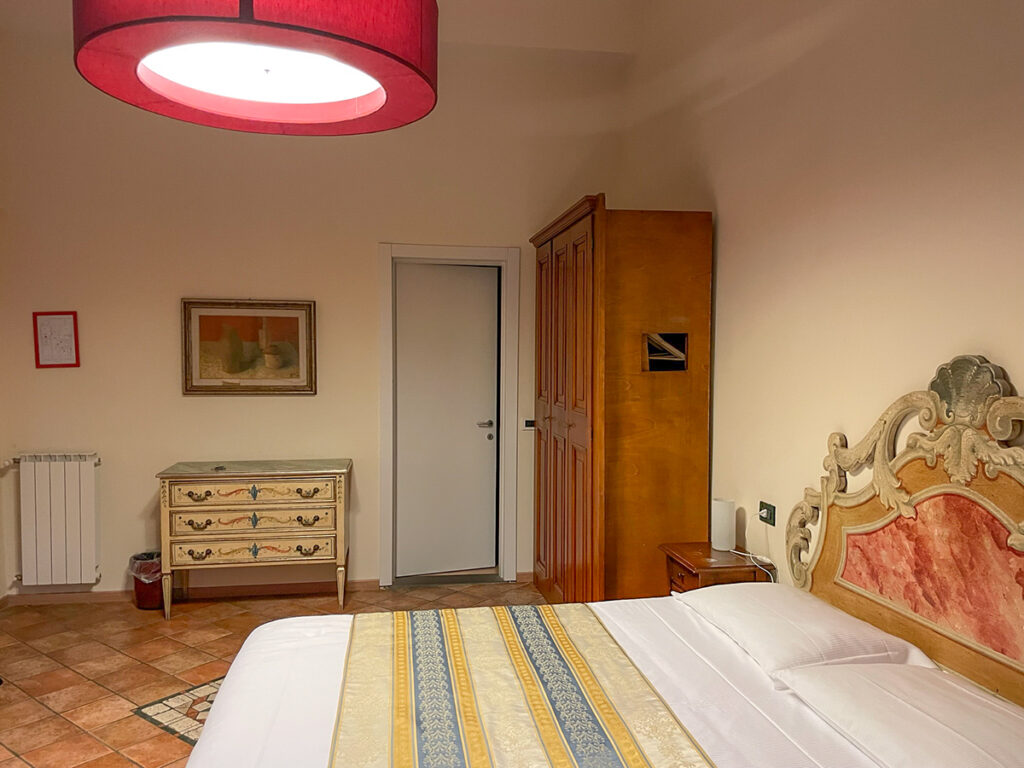
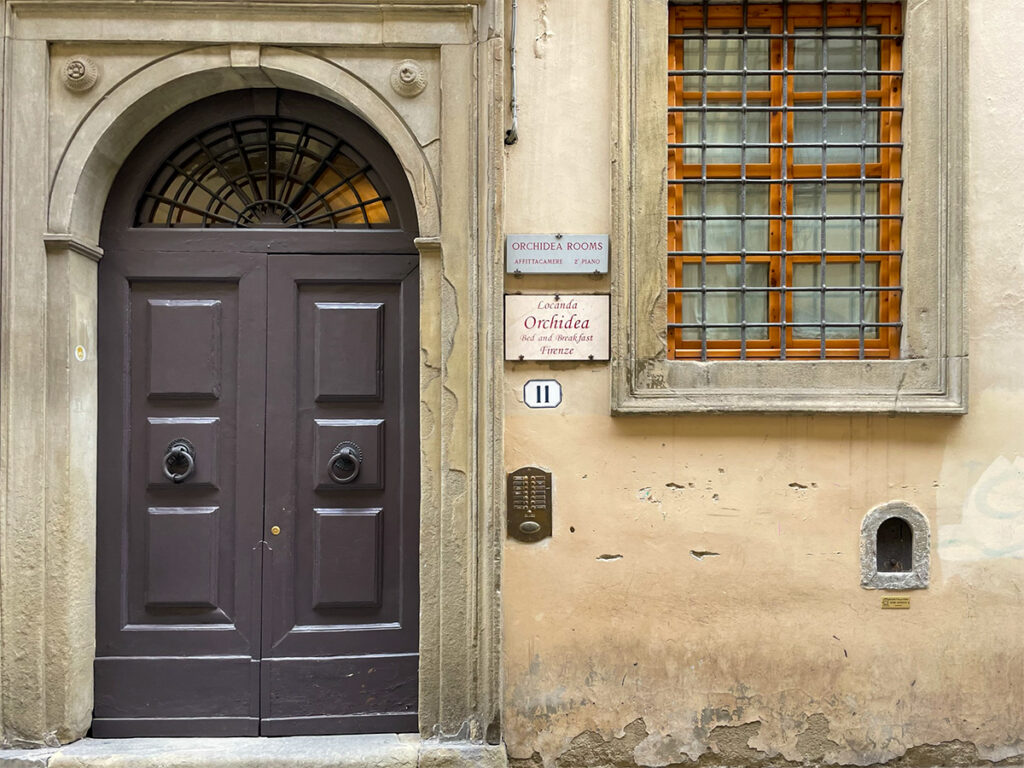
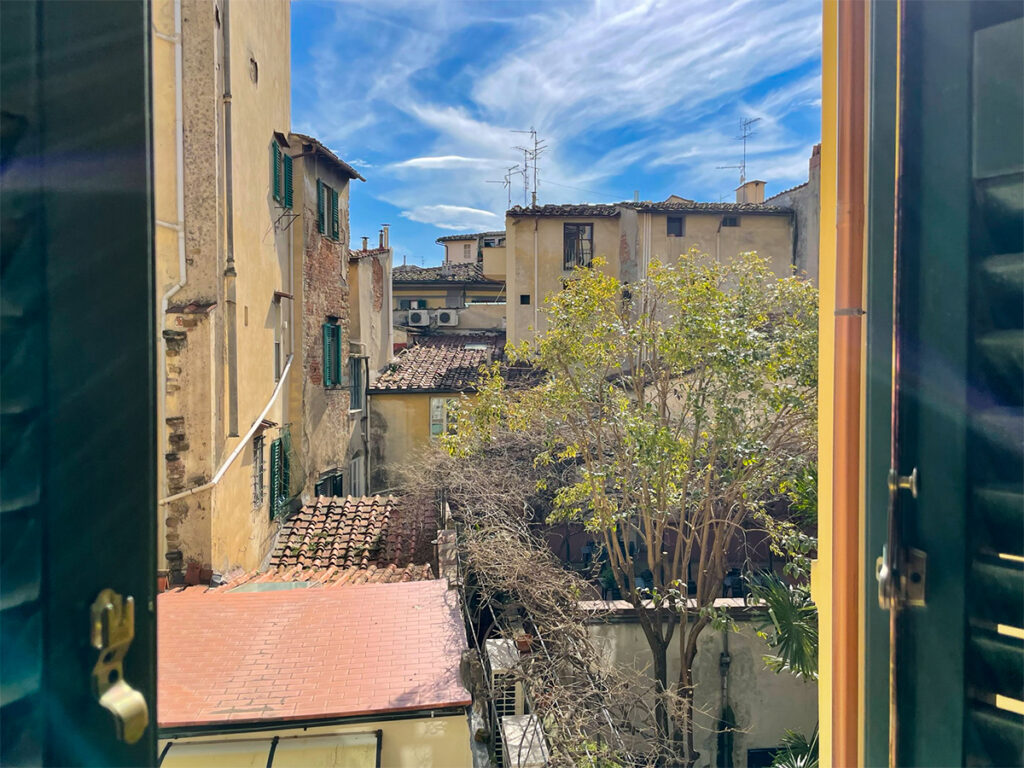
I spent almost two weeks in Florence staying at Locanda Orchidea, and I couldn’t recommend this charming B&B highly enough. Located in a 13th-century historical palace, Torre di Donati, that may have belonged to Dante’s family, Locanda Orchidea is full of character.
And it is conveniently located within a 5-minute stroll to Piazza del Duomo and a 10-minute stroll to Piazza della Signoria. Piazza di San Lorenzo and Santa Croce are within a similar distance. This means that if you feel a bit weary of having some shopping to drop off, you can easily detour to your hotel from anywhere on this itinerary.
2 Days in Florence: Day 1
The main focus of Day 1 is the two squares, Piazza del Duomo and Piazza della Signoria, and the art and monuments in these squares with several detours to the nearby must-see sites and hidden gems.
Piazza del Duomo and the Duomo Complex
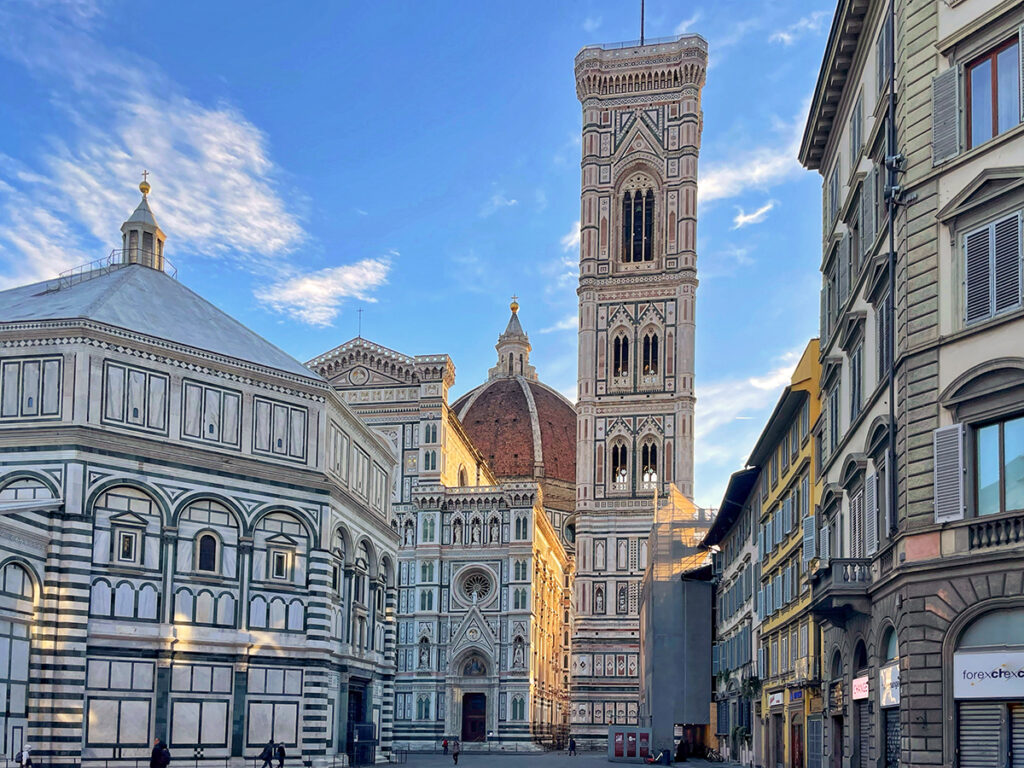
- Time to visit: 1-3 hrs
- Official website / tickets
- Best skip-the-line tour
Start your first day in Florence by visiting the Duomo – one of the most recognizable buildings in Europe. Formally called Cattedrale di Santa Maria del Fiore, the Duomo is more than one building – it is an entire complex.
The Duomo Complex comprises the Cathedral itself with Brunelleschi’s famous dome, the 85-meter bell tower or Giotto’s Campanile, the Baptistery, Santa Reparata – an ancient cathedral underneath the Duomo, and the Duomo Museum that holds all the original artworks from the complex. The Duomo Museum is the building where Michelangelo worked for three years carving his famous David from an enormous slab of marble. So you are literally walking in his footsteps there.
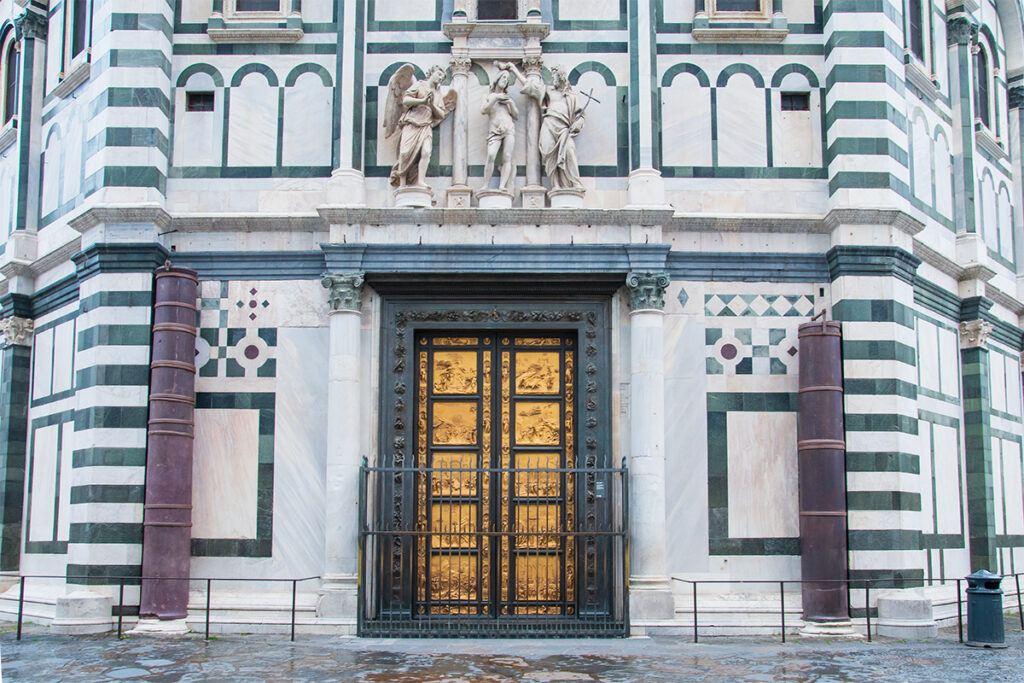
There are plenty of options for exploring Piazza del Duomo and the Duomo Complex. You can simply explore the buildings from the outside. The cathedral is enormous, so you can meander around it and admire the Campanile and the magnificent Gates of Paradise on the Baptistry (the bronze doors that face the cathedral).
But if you are reasonably fit and don’t mind narrow staircases and heights, you should really climb the dome of the Duomo. The dome itself is a masterpiece of Renaissance architecture. For a long time, the cathedral stood with a gaping hole in its roof because the brightest minds of the time could not figure out how to build a dome this big. Until Filippo Brunelleschi came along and, with support from Cosimo di Medici, designed his ingenious dome, the largest ever built at the time, in 1456.
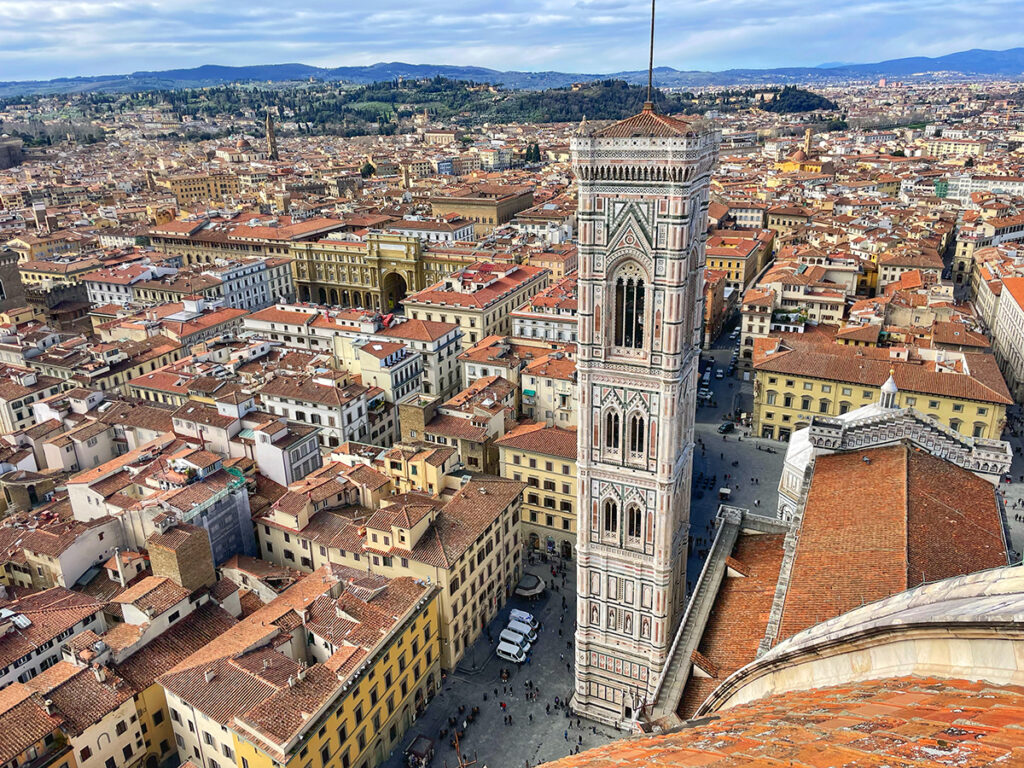
And as you can imagine, the views of Florence from the top of the dome are to die for. Of course, if you want the view of the dome, you’ll need to climb another 418 steps to the viewing platform on Giotto’s Campanile.
The tickets for the Duomo complex are not entirely straightforward, so you’ll need to be prepared. The entrance to the cathedral is free, meaning there are no skip-the-line tickets for it. And this includes Santa Reparata as well. The only way to avoid spending 1-2 hours in the queue is to book an organized tour.
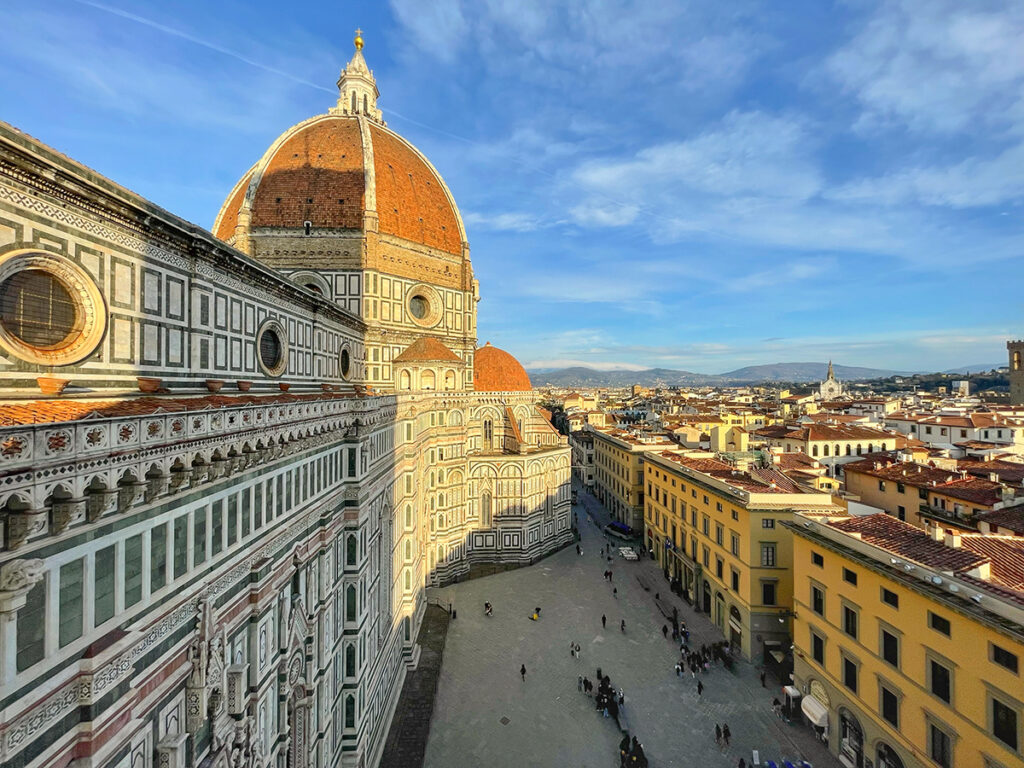
Alternatively, you can purchase (in advance) the Brunelleschi Pass from the official cathedral website. The pass gives you access to all monuments of the complex (although you’ll still have to queue up to enter the Duomo) and is valid for 3 days. Since you are spending more than 1 day in Florence, this pass is good value.
Depending on your time and interest, you can pick a tour that includes the cathedral and the dome climb. These tours run for about 1 hour, after which you climb to the top of the dome. So allow at least 2 hours.
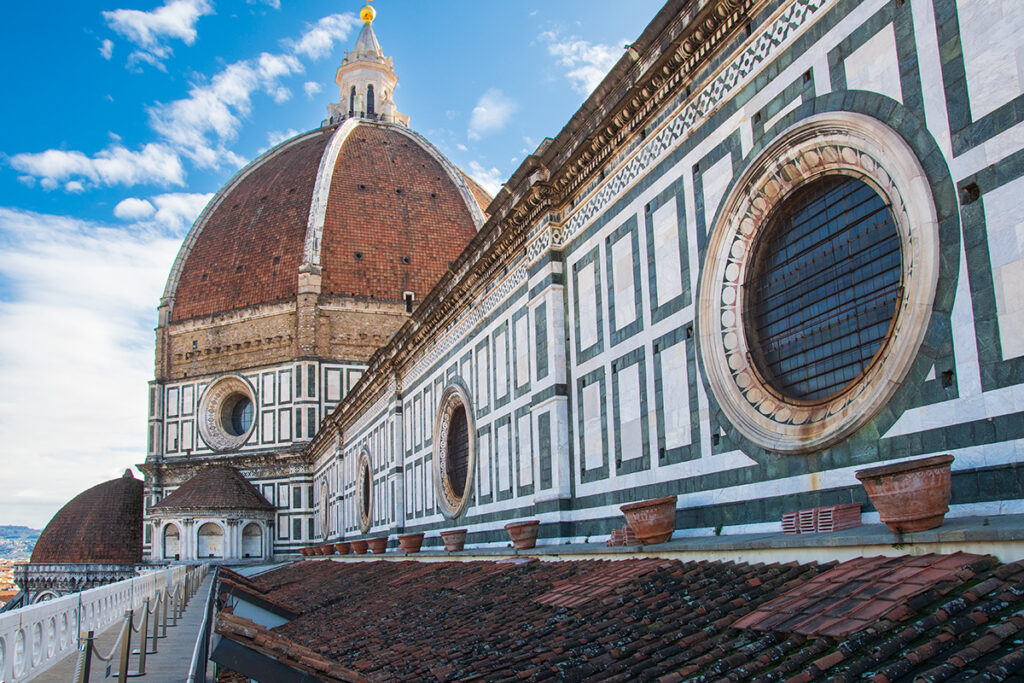
.
But if you are looking for something a little extra, I highly recommend the tour that includes exclusive access to the roof terrace so you can see the dome and the beautiful roof up close. The tour includes a visit to the Duomo museum so you can see the real Gates of Paradise (the ones on the baptistery are a copy) as well as Michelangelo’s unfinished Pieta, Donatello statues and other great works of Renaissance art.
Then explore the rather plain interior of the cathedral before climbing first to the roof terrace and then to the top of the dome. The tour lasts between 2.5 and 3 hours. Make sure to keep your ticket if you want to climb Giotto’s campanile and visit the Baptistery later.
Michelangelo’s David
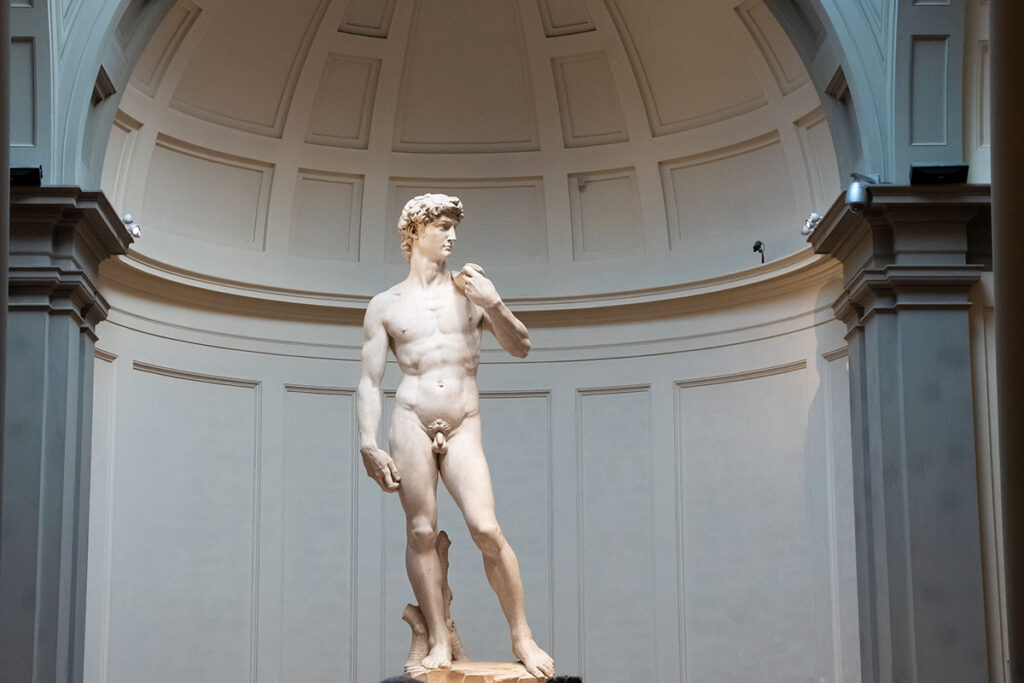
- Time to visit: 1 – 1.5hrs including entrance queue
- Official website/tickets
From the Duomo, head to Gallery dell’Academia to see the most famous statue of the Renaissance – Michelangelo’s magnificent David. This 5-meter-tall sculpture was the first colossus created after the fall of the Roman culture.
Today, David is a symbol of Florence, and there are actually 3 Davids in the city: the original statue carved by Michelangelo, a reproduction that stands in front of Palazzo Vecchio, and another at Piazza Michelangelo. And you’ll have a chance to check out all three in your 2 days in Florence if you follow this itinerary.
The Academy Gallery is a 10-minute stroll from Piazza dell Duomo, but you need to arrive 15 minutes before your allocated time slot, and you’ll also need to exchange your electronic ticket for a paper one (ask a security guide to point out the ticketing office). And then make sure to join the correct queue – one with your time slot printed at the front.
The gallery is quite small, so if you are short on time and just want to see David and the main room of paintings (don’t miss Sandro Botticelli), you can do that in 30 minutes. But if you can, plan the full hour for a more relaxed experience.
Lunch
By now, you’ll be ready for lunch, and there are a couple of options to consider, depending on what you want to do next. One is to have lunch at one of the cafes around Piazza di San Lorenzo and then explore one of the Medici monuments.
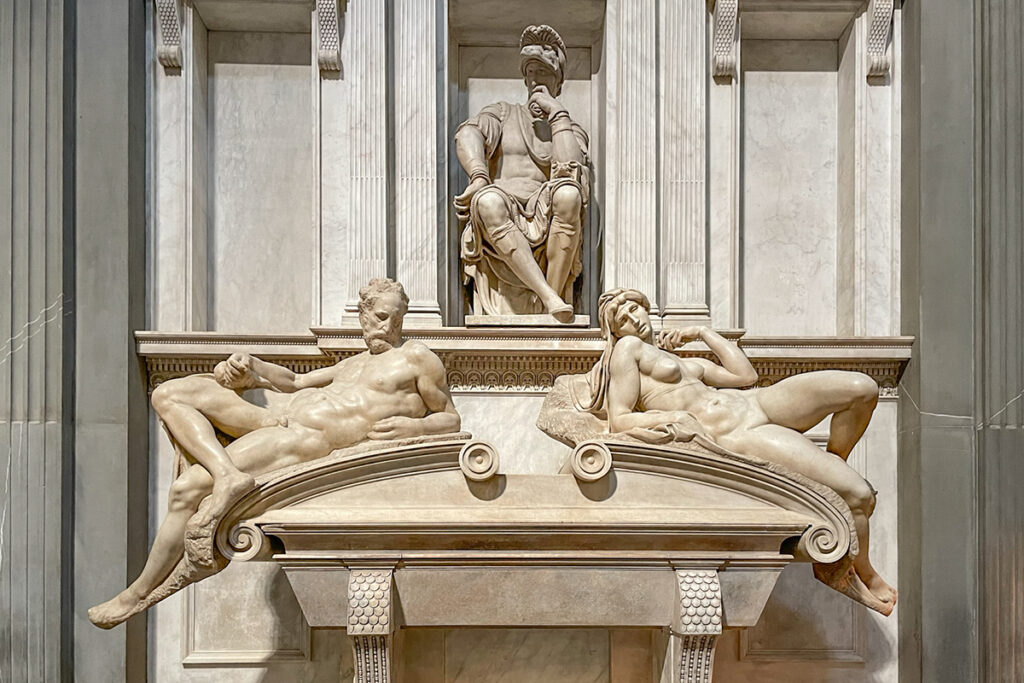
Tip: Keep in mind that cafes in tourist hotspots often have two sets of prices: one for takeaway and one for a sit-down meal. The sit-down prices can be 10 times higher. That’s why you often see Italians drink their coffee standing up by the bar or outside the shop.
Another option is to take a stroll to Piazza della Santissima Annunziata to see its sites and have lunch at the historic cafè Robiglio dal 1928 (via dei Servi 112/r). You’ll love the view of the Duomo from via dei Servi.
Option 1: Medici Quarter
The area around the Basilica of San Lorenzo used to be part of the Medici Quarter at the time of Cosimo the Elder and Lorenzo the Magnificent. The quarter encompassed the Basilica, the Medici Palace (Palazzo Medici-Ricardi), and San Marco Monastery. You won’t have the time to see them all, but you should try to visit one.
Medici Chapels
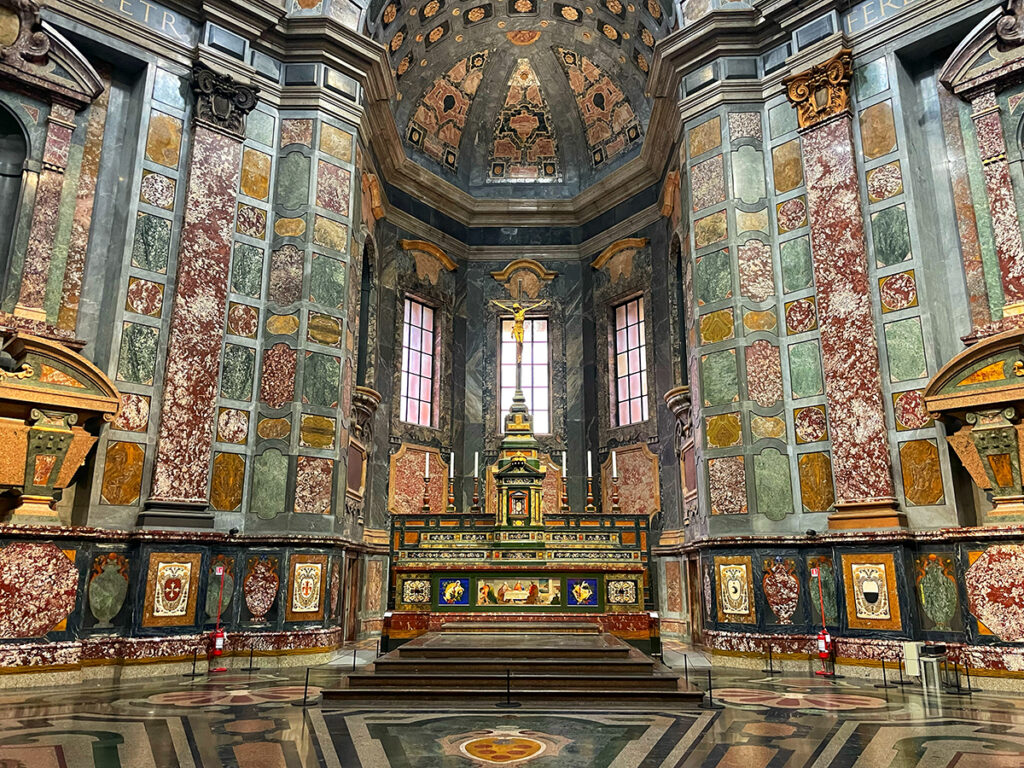
- Time to visit: 30 min to 1hr
- Official website/tickets
The most opulent site is the Medici chapels. Designed by Michelangelo, the chapels lie adjacent to the parish church of the Medici family – the Basilica of San Lorenzo but have a separate entrance. As with everything else, you can purchase your ticket in advance on the B-ticket website – the official website for the State Museums of Florence.
There are two main chapels: the New Sacristy, designed by Michelangelo, where his statues adorn the sarcophagi of prominent Medici family members, and the monumental Chapel of the Princes, strikingly decorated with white, red, and green marble and housing the sarcophagi of the most distinguished (male) Medicis.
San Marco Monastery
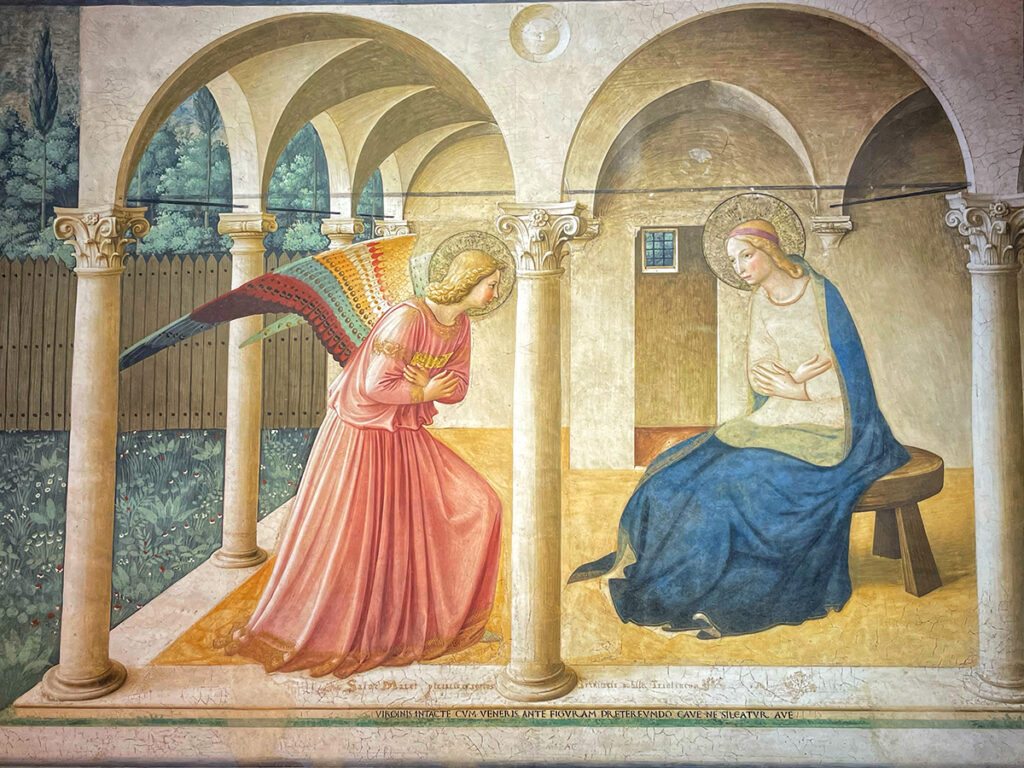
- Time to visit: 1hr
- Official website/tickets
San Marco Monastery is a stunning and peaceful escape from the buzz of Florence. The monastery is mainly famous for two of its former Dominican monks who became highly influential figures in Florence: Fra Angelico, an artist of the early Florentine Renaissance, and Savonarola, who practically brought the Florentine Renaissance to an end.
Today, San Marco houses the biggest collection of Fra Angelico’s art, including his frescoes in the monks’ cells upstairs. If you are visiting during the peak season, you will enjoy the tranquil setting of San Marco.
Option 2: Piazza della Santissima Annunziata
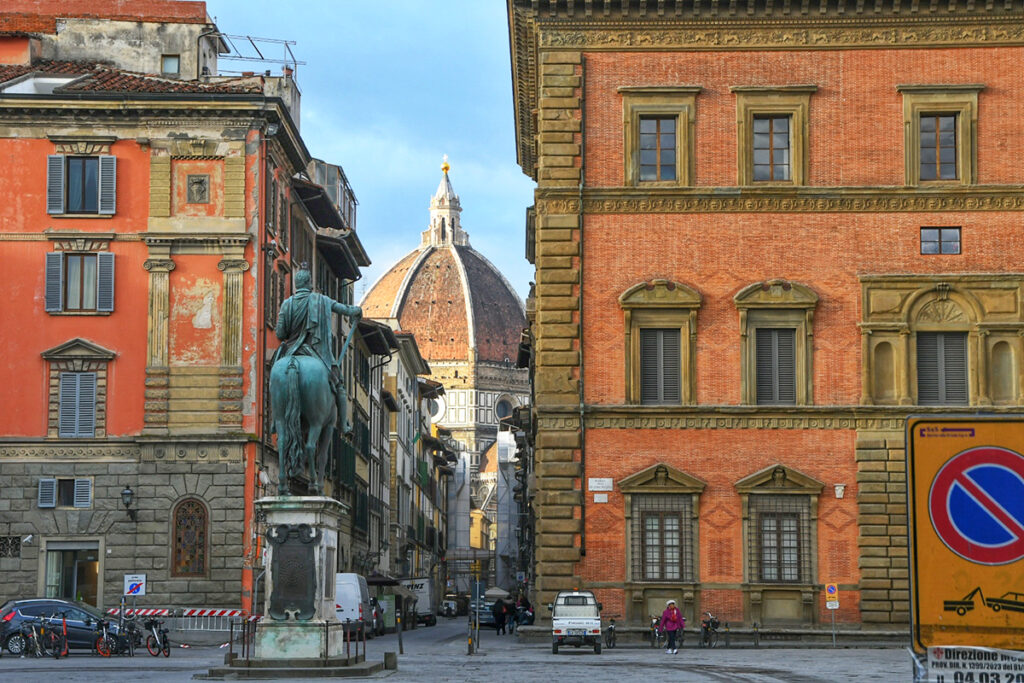
If you don’t feel like exploring the palace and the chapels, take a stroll from the Academy Gallery back to Duomo via Piazza della Santissima Annunziata. This beautiful square is one of the few spaces in Florence designed and built in the Renaissance style, yet it remains largely off the tourist radar.
The most important monuments on the square are the Hospital of the Innocents (Ospedale degli Innocenti), originally designed by Brunelleschi as an orphanage (the first one ever built in Europe), and the beautiful church of Santissima Annunziata (Basilica della Santissima Annunziata). Both are free to visit, and there are no queues.
Once you are done at the square, follow the gaze of the equestrian statue of Ferdinando I towards the beautiful view of the Duomo, and you will find cafè Robiglio dal 1928 (via dei Servi 112/r) – a lovely historic cafe to break for lunch.
Browse Artisan Shops
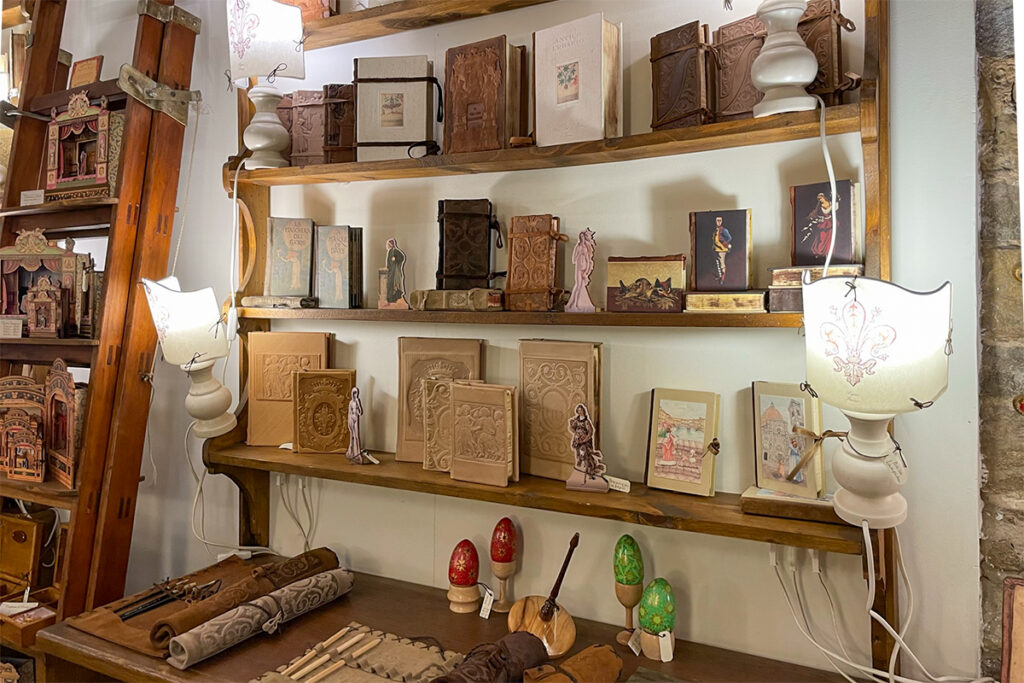
For a bit of a break from the sightseeing, check out some artisan shops. While most of Florence’s artisan shops are located in Oltrano, on the southern bank of the Arno River, there are a few wonderful shops in the city center.
Right on Piazza del Duomo il Papiro is world-famous for its handmade marbled paper notebooks, journals, and writing paper – the Florentine specialty.
Nearby is L’Arte de’Ciompi (Via de’ Cerretani 18R), which sells gorgeous art prints, handmade leather-bound books and journals, lamp shades and ancient tarot cards.
Stroll Along via dei Calzaiuoli
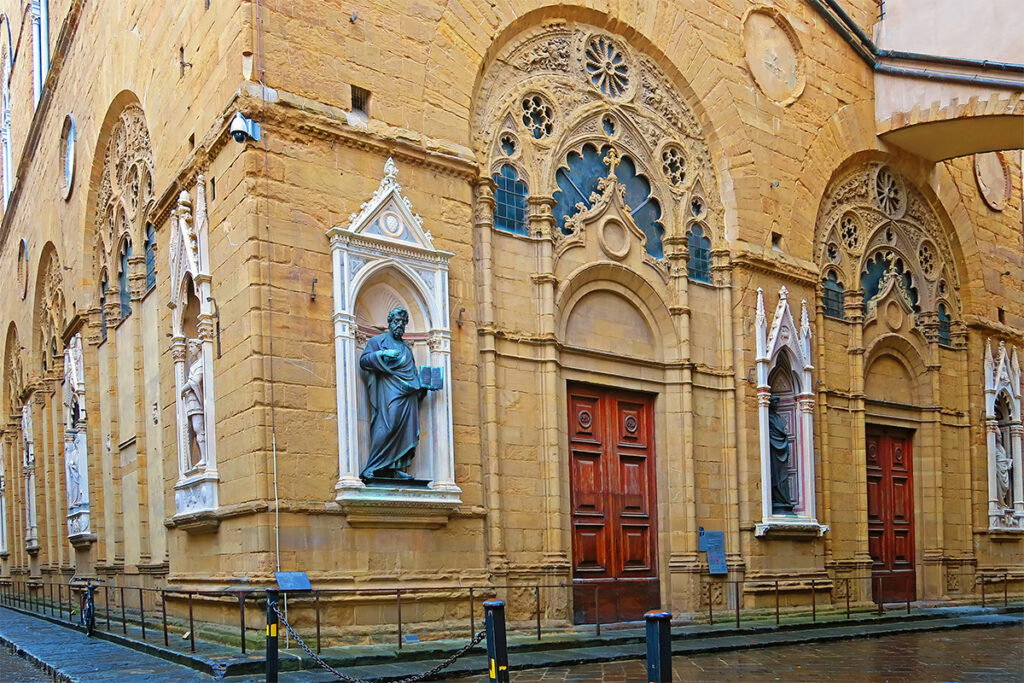
Once you are back at Piazza del Duomo, find via dei Calzaiuoli and follow this short street towards Piazza della Signoria. This pedestrian-only street has been the major thoroughfare in Florence for 2,000 years. Today it’s lined with upmarket shops and gelaterias.
Don’t miss the church of Orsanmichele. In the 14th century, the guilds of Florence were charged by the city to commission statues of their patron saints to embellish the facades of the church. The statues were the symbols of pride to the gilds, so they spared no expense and commissioned Donatello, Ghiberti, and Brunelleschi, among others, for the work.
For centuries, the facade of Orsanmichele has been a fine display of public Renaissance art. Today you see copies of the originals (the original statues are kept in the museum inside the church).
Piazza della Signoria
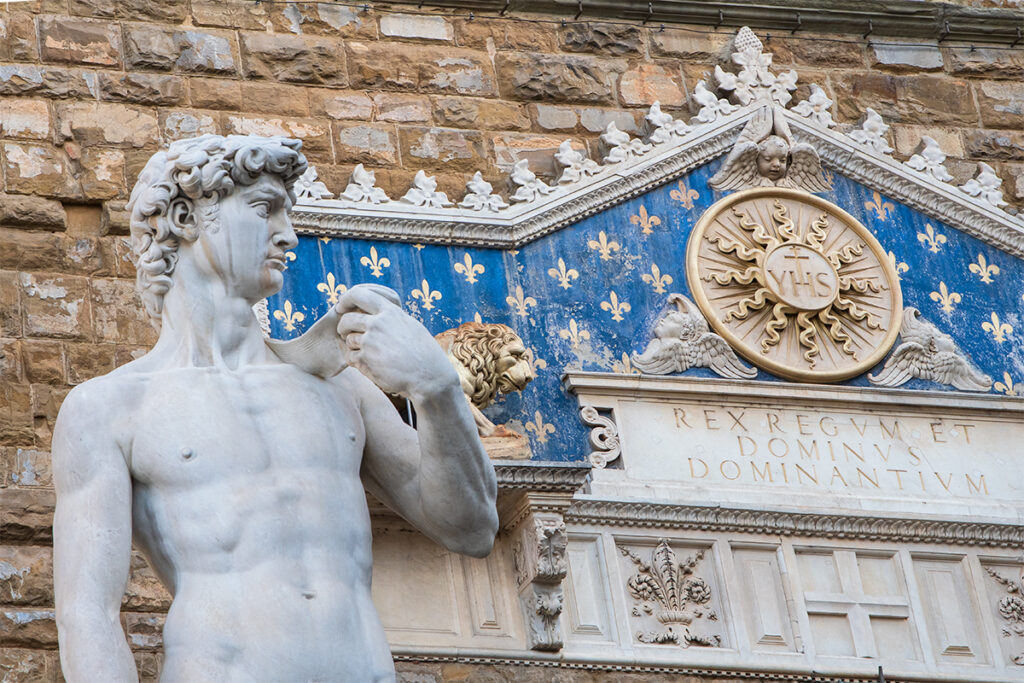
Via Calzaiuoli brings you to the second most important square in Florence, Piazza della Signoria. Dominated by the fortress-like structure of Palazzo Vecchio – the seat of Florentine government since the 13th century, Piazza della Signoria is the civic heart of Florence and an open-air museum of Renaissance art, which makes a visit to the piazza one of the best free things to do in Florence.
The entrance to Palazzo Vecchio is flanked by two colossal statues: a replica of Michelangelo’s David, the symbol of Florence, and Bandinelli’s Hercules and Cacus. To the left of the palace, another colossal male nude, Neptune, towers over a fountain.
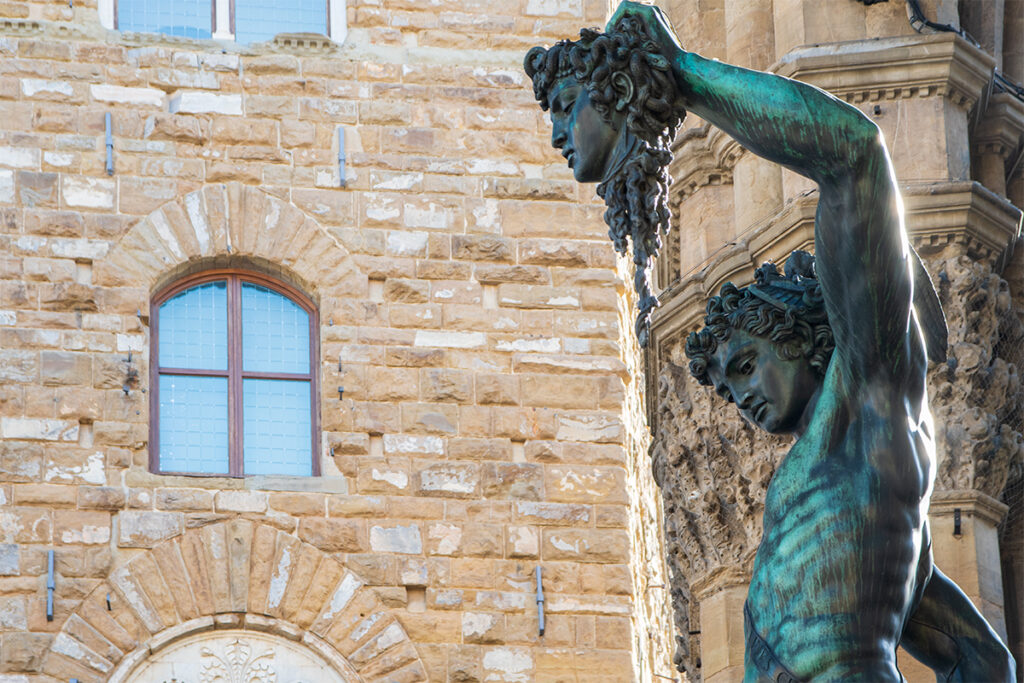
To the right of the palace is the Loggia dei Lanzi – an open-air sculpture gallery crowned with Cellini’s magnificent Perseus with the Head of Medusa.
For an iconic experience, have a coffee and some mouthwatering afternoon sweets at Rivoire and enjoy the view of Piazza della Signoria.
Palazzo Vecchio
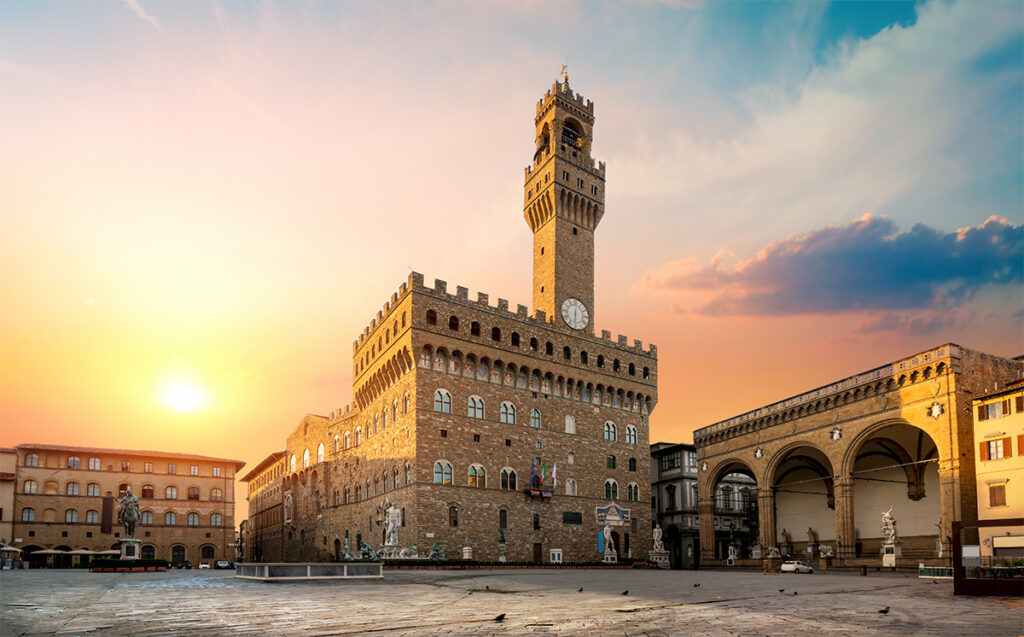
- Time to visit: 1-2 hrs
- Official website/tickets
- Best guided tour
Towering over the southeast corner of the Piazza Della Signoria, Palazzo Vecchio looks more like a fortress than a palace. And that is because when it was built in 1299, security was much more on Florentines’ minds than refined architecture. However, the interior of the palace is anything but rugged. It is exquisitely refined.
In my view, it is the most aesthetically beautiful and interesting of the three Medici palaces in Florence. From the monumental grandeur of the Hall of the Five Hundred to exquisitely beautiful frescoes in the apartments and room of maps, Palazzo Vecchio is practically a smaller version of the Vatican museums.
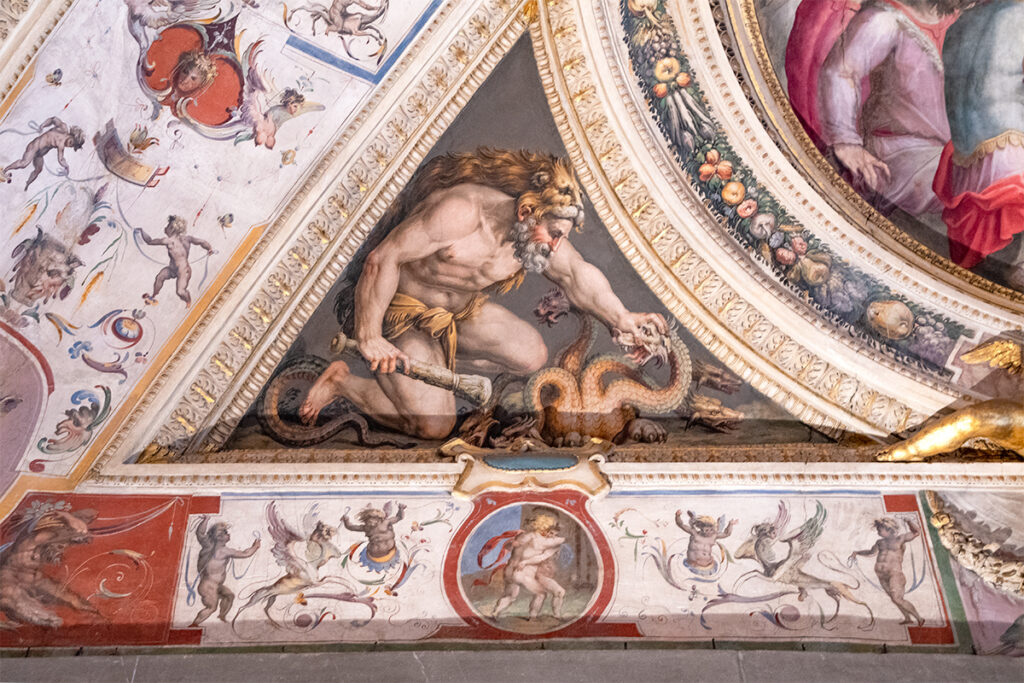
Palazzo Vecchio is open quite late – until 6 or 7 pm, depending on the season, which makes it a great option for the late afternoon visit. You can visit the palace independently by purchasing a ticket in advance on the website for Florentine State Museums. Keep in mind that you’ll need to exchange your electronic ticket for a paper one at the ticket office at the palace, which can take some time.
Alternatively, you can opt for a guided tour of the palace – there is a lot to see at Palazzo Vecchio. This tour starts at 4.30 pm and lasts 1.5 hours. But make sure to exchange your booking for a paper ticket prior to the tour.
Another option is to combine your visit to the palace with the fantastic Secret Passages tour. This tour, run by the Palace’s official guides, is a real treat. It takes you into the hidden passages concealed behind paintings in different rooms not otherwise accessible to the public. And the best thing is that after the tour, you are welcome to explore the rest of the palace at your own pace. The catch is – the tour starts at 11.30 am. So if this is something you would like to do, book it for Day 2 of your 2 days in Florence.
Tip: If you want to climb the palace’s bell tower, called Arnolfo Tower, for some stunning views of the city and the Duomo, you should get your ticket when you visit the ticket office. Tower tickets are not available online, and chances are they will be sold out for the day of your visit. But you probably won’t want to climb another 400+ steps after claiming the dome of the Duomo. So you could get the ticket for the following day and climb the tower after your visit to Uffizi Gallery next door.
I have a guide to visiting Palazzo Vecchio that has many images and details about the different areas of the palace. The palace is not huge, so you can comfortably explore it in about an hour.
Ponte Vecchio
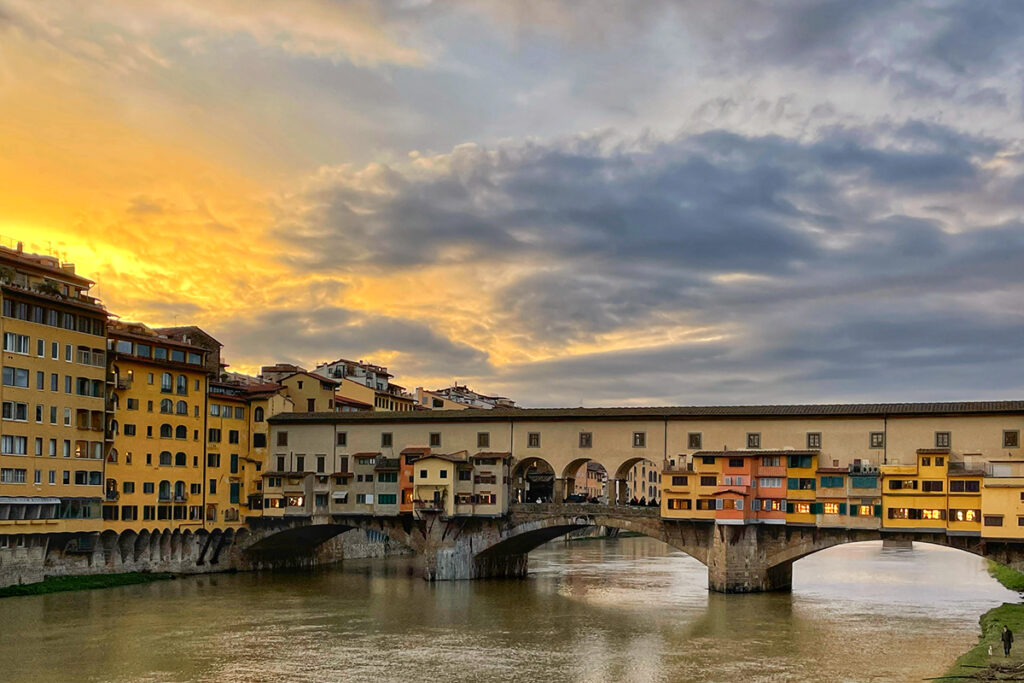
The colourful shop-studded Ponte Vecchio (old bridge) is one of the most iconic sights in Florence. And it also happens to be a wonderful spot for catching the sunset. So check the sunset time for your dates (here) and either stroll to the bridge before or after dinner. Most restaurants in Florence don’t open until 6 pm for dinner.
The best spot for watching the sunset is the riverbank just below the Uffizi Gallery. And while you are here, check out another gorgeous artisan shop, Signum. There are three Signum stores in Florence, but the one at Ponte Vecchio is the most atmospheric.
Alternatively, you can take one of Florence night tours either at sunset or in the early evening.
Dinner at Antico Ristorante Paoli 1827
To end the first day of your 2 days in Florence in style, book a table for dinner at Antico Ristorante Paoli 1827.
The oldest restaurant in Florence, Paoli is located in a beautiful Renaissance building that used to be a church. So, think vaulted ceiling and stunning frescoes on the walls.
Make your booking as far in advance as you can; this is one of the most popular restaurants in Florence. And once there, don’t miss their tiramisu for dessert.
2 Days in Florence: Day 2
Day 2 is about discovering more spectacular art and panoramic views of Florence with a few optional additions.
Uffizi Gallery
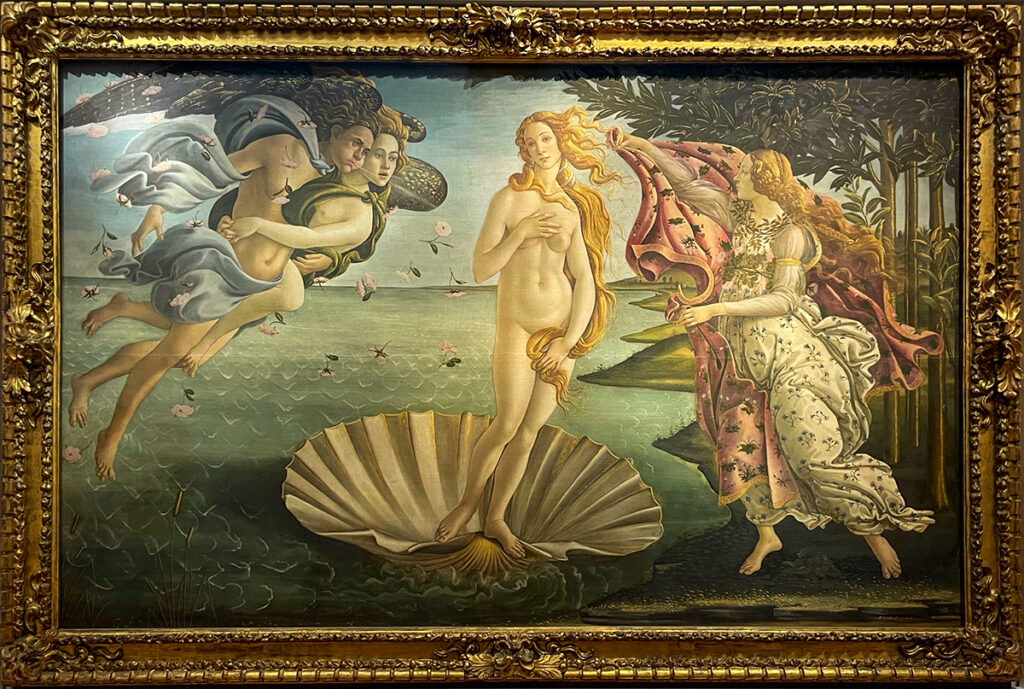
- Time to visit: 2 hrs
- Official website/tickets
- Guided tour
Uffizi Gallery is a true art lover’s paradise. The museum houses some of the world’s most iconic paintings, sculptures, and other art forms. Works by da Vinci, Rafael, Michelangelo, Botticelli and Caravaggio are just a few highlights.
Even if you don’t consider yourself an art connoisseur, don’t miss your chance to gaze at Botticelli’s Birth of Venus, one of the most famous paintings in the world, or find yourself in a room of Leonardo da Vinci’s paintings.
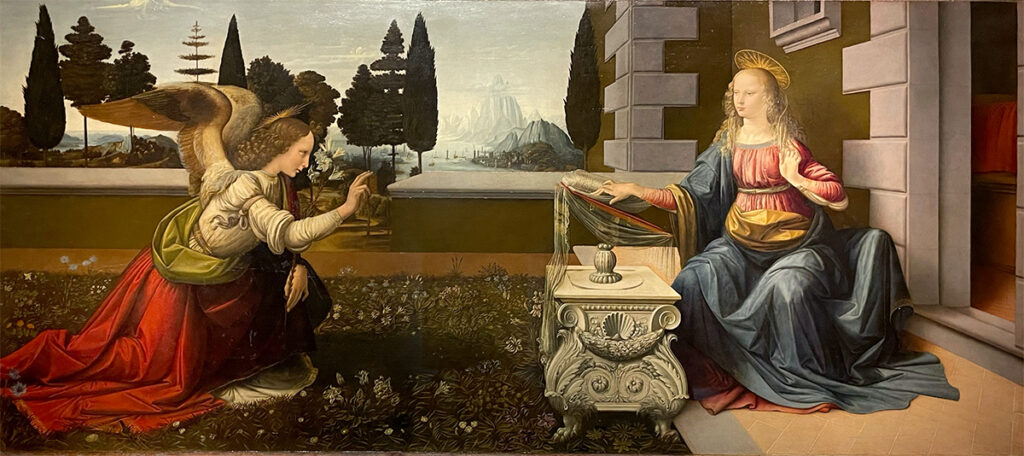
The trick to enjoying Uffizi Gallery is to visit first thing in the morning before the tour groups arrive. Aim to book your ticket for the first entry – at 8.15 am. This will give you an hour and a half of peace and quiet and, most importantly, unobstructed views of the art.
Tip: Don’t forget to exchange your electronic booking for a ticket. Uffizi courtyard can be confusing with several queues for different things. The ticket office is on your right, if you are looking towards the Arno River. At the far end of the building from the river. Once you get your ticket, join the queue on your left, about halfway along the bulding. If you are visiting at 8.15 am, there isn’t likely to be a general queue yet, but still try to make sure that you are joining the ‘timed entry’ queue for your time slot (it should be quite short).
The art collection at Uffizi is immense. But the gallery layout is quite easy to navigate. When you enter, the signage will guide you upstairs to the second floor, where the rooms are arranged chronologically, from medieval art to the Renaissance.
Towards the end of the hall, you’ll find Botticelli’s Birth of Venus and The Allegory of Spring, da Vinci’s Annunciation, Michelangelo’s Doni Tondo, and Rafael’s Madonna of the Goldfinch.
On the first floor, don’t miss a series of portraits of the most well-known Medici family members and Caravaggio’s Medusa shield.
Optional: Arnolfo Tower & Secret Passages Tour
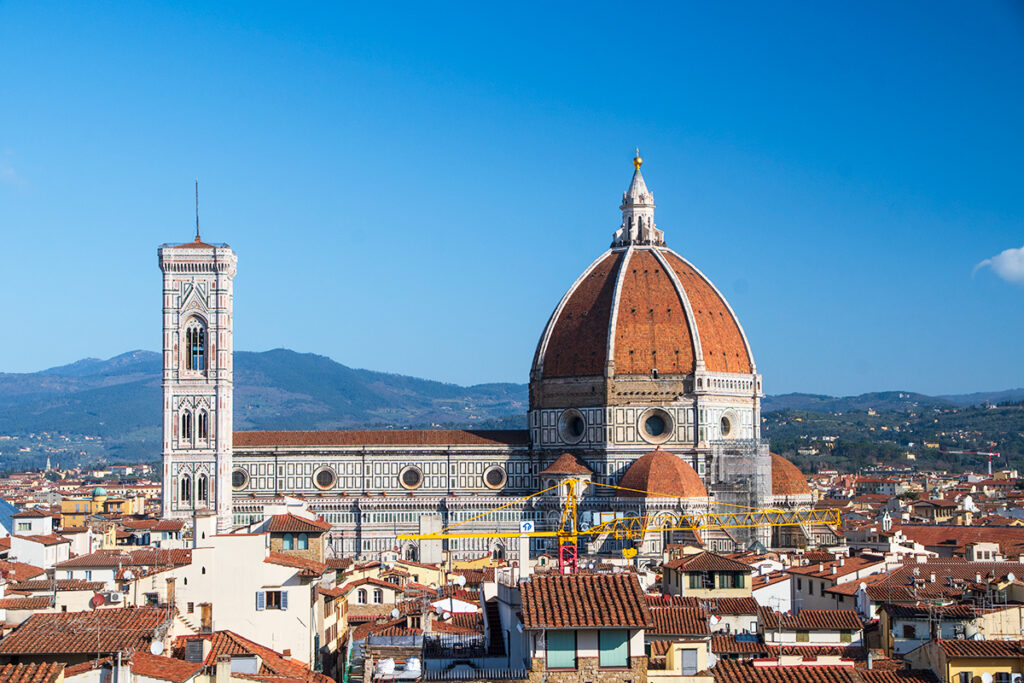
If you booked the Palazzo Vecchio Secret Passages tour for 11.30 am, stroll to the palace just after 11 am to exchange your electronic booking for the paper ticket and meet your guide on the ground level of the palace
And if you have your ticket for Arnolfo Tower, after the tour, climb 406 steps along a narrow stone staircase to be rewarded with a 360-degree panorama of Florence from two different observation platforms at the top of the tower.
Santa Maria Novella Church
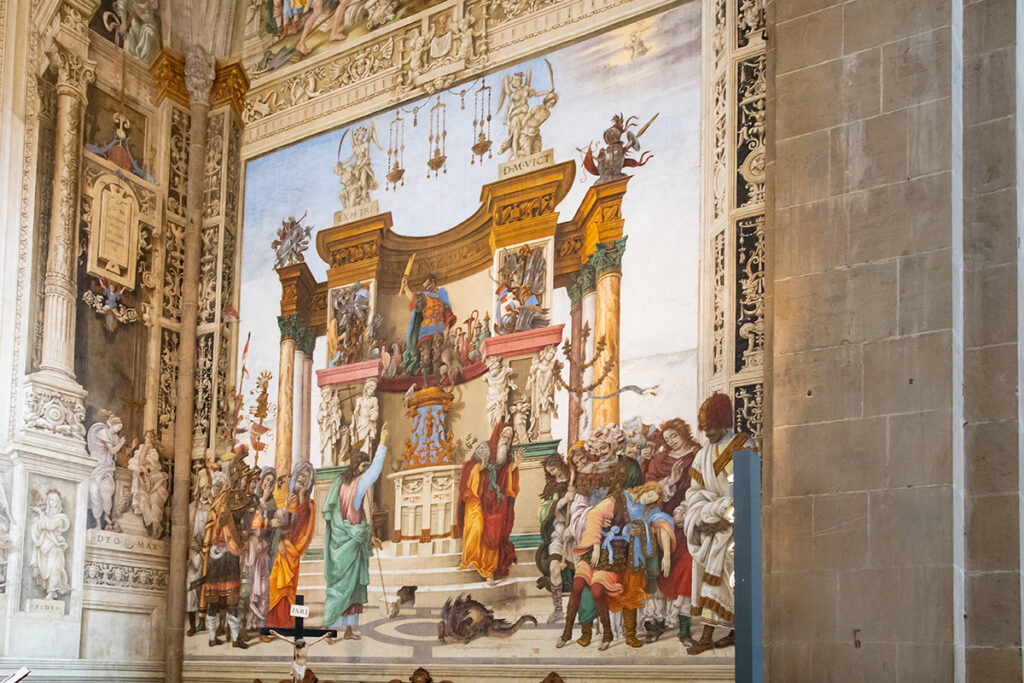
- Time to visit: 30-40 min
- Official website/tickets
- Ticket & Audioguide combo
I find the Santa Maria Novella Basilica (Basilica di Santa Maria Novella) to be Florence’s most beautiful church. Over the centuries, its interior has been decorated by works of Giotto, Duccio, Brunelleschi, Botticelli, Masaccio, Ghilrlandaio, Filippino Lippi, Vasari, Paolo Uccello and even Michelangelo.
The entire history of the Florentine Renaissance can be traced in this church, and its frescoes have inspired many artists, including da Vinci, who worked on the cartoon for his Battle of Alighieri in this church while hosted by the monks.
My favourite part of the church is the Chapel of Filippo Strozzi to the right of the altar, Filippino Lippi’s amazing frescoes, his last works, in fact.
There are also crucifixes by Giotto (at the center of the nave) and by Brunelleschi (in the Gondi Chapel), Holy Trinity by Masaccio, Ghirlandaio’s frescoes in the Tornabuoni Chapel, and Brunelleschi’s pulpit from which Galileo was denounced by the church.
Santa Maria Novella Pharmacy
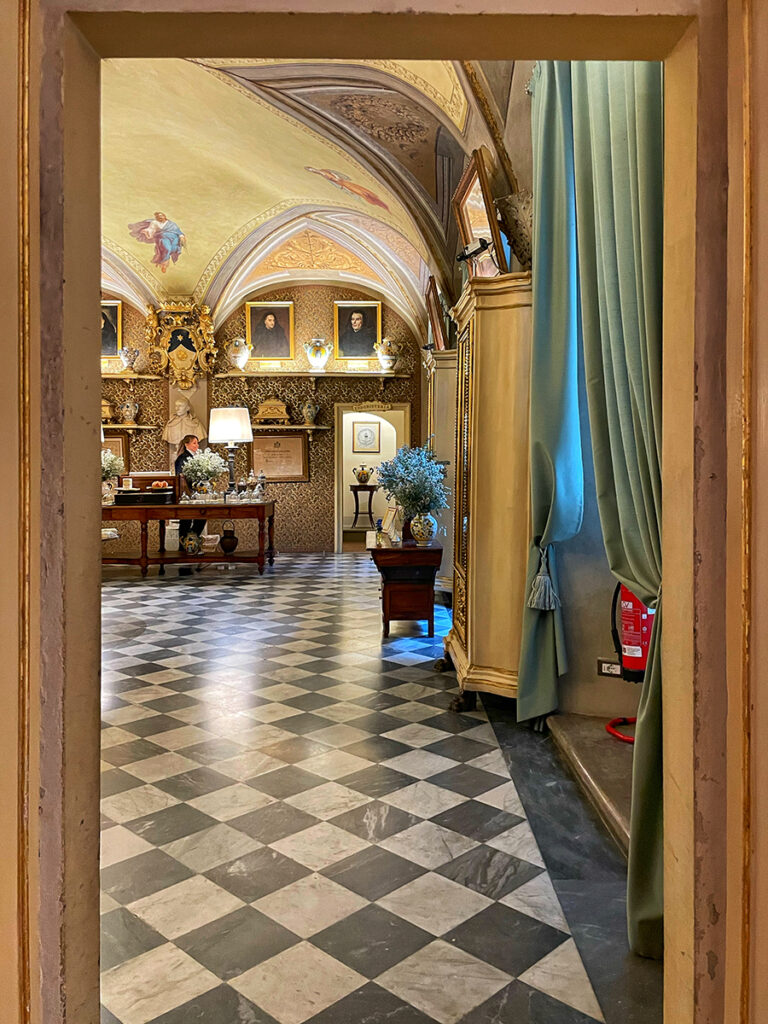
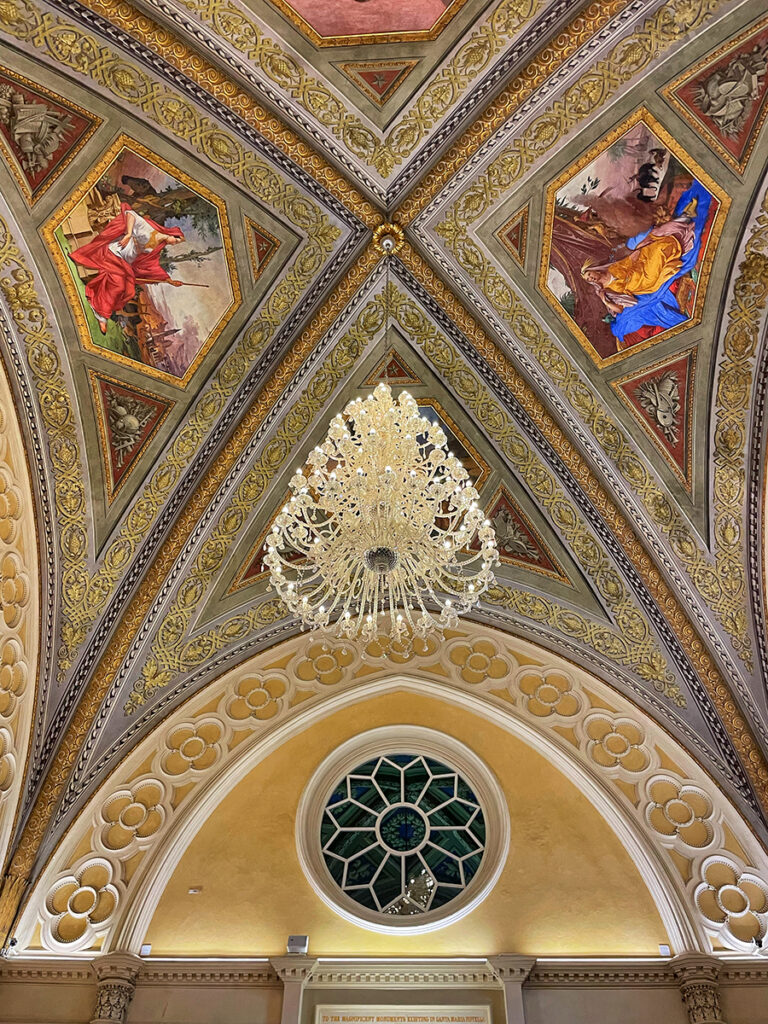
Adjacent to the courtyard of Santa Maria Novella church is the most beautiful shop in Florence – Officina Profumo-Farmaceutica di Santa Maria Novella. It was established as a pharmacy by the Dominican friars living at the monastery, and by 1381, the friars were selling rose water extract as a disinfectant, thought to be particularly useful during the plague. The friars grew their medicinal plants in their kitchen garden.
The present pharmacy dates to 1612, and it is decorated with exquisite Renaissance frescoes and a vaulted ceiling. When Catherine di Medici became the queen of France, the friars created a special perfume for her that is still sold in the store. Whether you buy anything or not, the store and the small museum are very much worth a look.
Basilica of Santa Croce
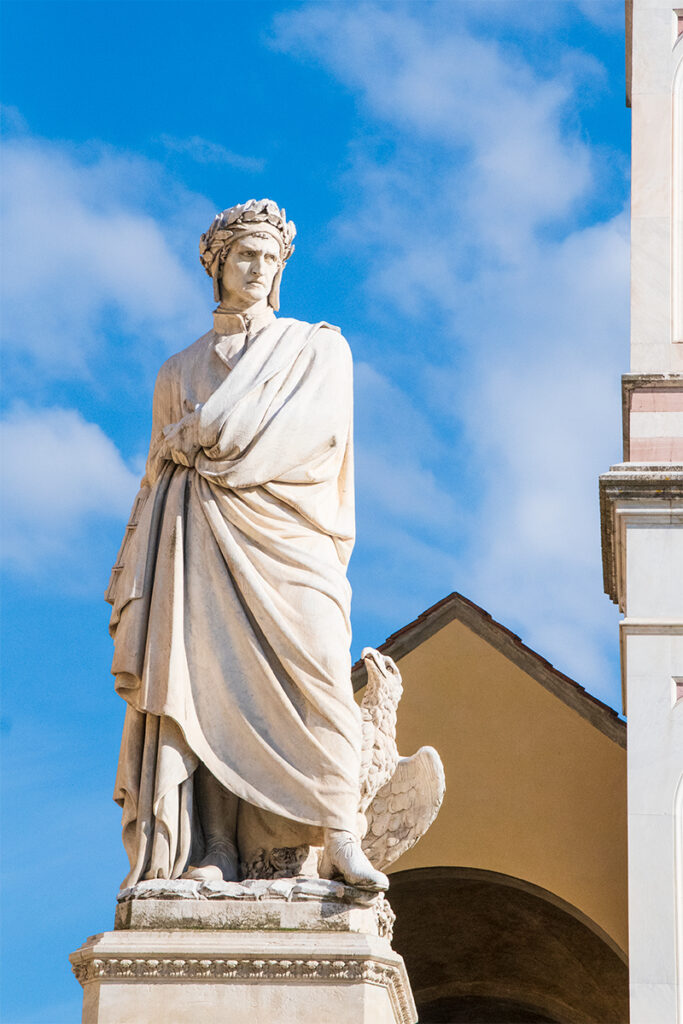
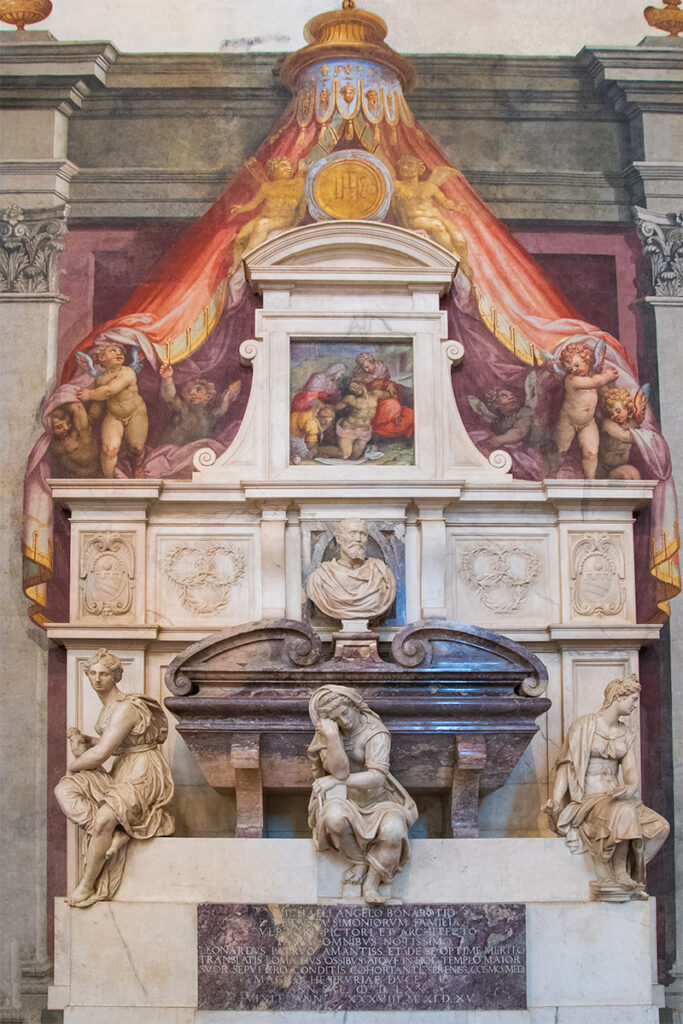
- Time to visit: 30-40 minutes
- Official website/tickets
Stroll across Florence’s now-familiar historic centre to the Basilica di Santa Croce (Basilica of the Holy Cross). One of the most famous churches in Florence, Santa Croce is the principal Franciscan church of Florence and the biggest Franciscan church in the world (of St Francis of Assisi fame).
Although today, it is mostly famous for being the burial place of some of the most illustrious Italians, including Michelangelo, Machiavelli, Galileo, Rossini, and an honorary sarcophagus of Dante, even though the poet’s remains are buried in Ravenna, where he died. Such famous dead inspired the basilica’s other name – the Temple of the Italian Glories.
Unsurprisingly, the church is decorated with Renaissance masterpieces, including frescoes by Giotto, a crucifix by Donatello, a chapel designed by Brunelleschi, and Michelangelo’s tomb designed by Vasari.
Sunset Views Over Florence
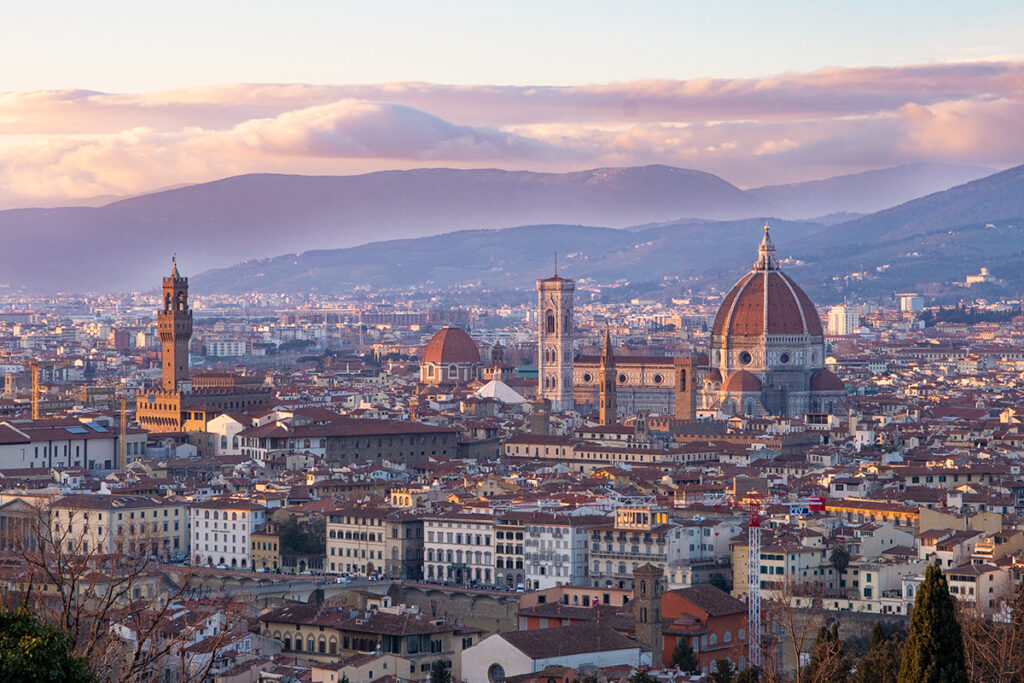
Finish your two days in Florence in a spectacular fashion with sunset views over the city. You have two options, and both are about a 30-minute walk from the Duomo, across the Arno River and up a steep hill.
If you enjoy the party atmosphere, head to Piazza Michelangelo. It is a large square overlooking the city, with a replica of Michelangelo’s David and various food, drink, and souvenir stalls. Take a sit on the stairs, grab a glass of prosecco and enjoy the changing light over the beautiful townscape of Florence.
For something a little more low-key, head to Abbazia di San Miniato al Monte. The view here is almost the same, and instead of a party crowd, there is a beautiful medieval church here with an iconic facade of white, red, and green marble. If you visit the church, make sure you don’t interrupt the 6.30 pm service (you can wander around the church before or after the service).
How to Get to Florence
The most convenient way of getting to Florence is by high-speed train. Driving & parking in Florence can be a chaotic nightmare, and the high-speed trains are faster and more relaxing than flying. Direct trains from Roma Termini depart every 30 minutes, taking just over 1.5 hours.
The easiest way to book train tickets in Italy is via the Omio app. You can show your electronic tickets to the conductor in the app – no need to print anything. And you’ll have all your train tickets in the same place regardless of what train network you travel with.
More on Exploring Italy
- Renaissance Cats in Florence – A Feline Lovers Guide to Florentine Renaissance Art
- 3 Days in Florence – Exploring the Cradle of the Renaissance
- 2 Days in Florence: Detailed and Flexible Itinerary & Tips
- 1 Day in Florence Itinerary – the Best of the Italian Renaissance
- Things to Do in Florence in Winter and Why Visit in Winter
- Leonardo da Vinci in Florence: In the Footsteps of the Renaissance Master
- Guide to Visiting Palazzo Vecchio: Must-see Art and Hidden Gems
- Medici Florence – a Self-Guided Walk in the Cradle of the Renaissance
- 18 Weekend Breaks in Italy: Top Destinations to Visit and Things to Do
- Quo Vadis – Assisi B&B Where Comfort Meets Medieval Charm

